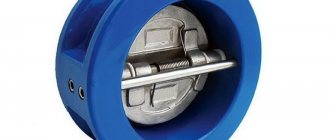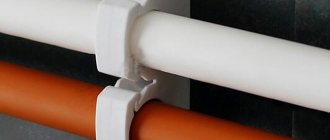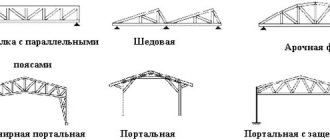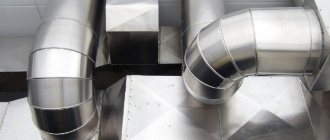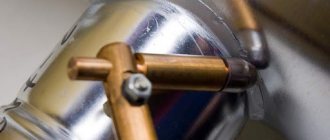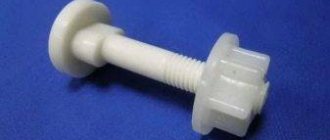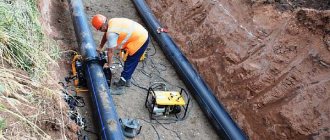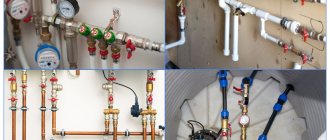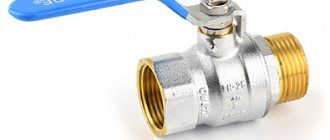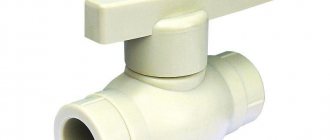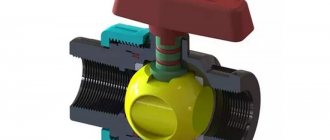Many manufacturers make different valves for the same diameter: full bore and partial bore. What is the difference between these cranes? Steel ball valves can be manufactured as full bore, i.e. The diameters of the holes in the connecting pipes are not narrowed. In order to save metal and reduce the effort and torque required to control the valves, partial bore ball valves are used, in which the diameter of the holes in the ball is smaller than the diameter of the holes in the flange. Partial bore ball valves have a higher coefficient of hydraulic resistance than full bore ball valves. Using the example of steel ball valves from the Marshall Trademark, you can clearly see the advantages and disadvantages of full-bore and part-bore valves.
.
Full bore ball valves.
Let's consider an all-welded ball valve with full bore and part bore pressure of 1.6 MPa for welding with a diameter of 200 mm. The designation of a full bore ball valve is 11s67pTsP Du 200, a partial bore is 11s67pTsP Du 200/150 - the narrowing reaches a diameter of 150 mm. A full bore crane has a mass of 44.7 kg and a kv capacity of 2720. At the same time, a partial bore crane has a significantly lower weight of 34.1 kg, but the kv capacity drops - 1830. Reducing the weight of the crane has an effect at the price of the latter. It is significantly lower than that of a full bore, sometimes almost 2 times. Thus, full bore valves have an advantage in the coefficient of hydraulic resistance, i.e. there is no loss of pressure, which means less load on the shut-off organ. And this is durability. For partial bore valves, due to the reduction in size and weight, the effort required for control, as well as the manufacturing cost, are reduced.
Partial bore ball valve.
The narrowing of the passage in a ball valve, as a rule, is performed symmetrically on both sides, but it can also be performed asymmetrically, which has the disadvantage that a ball valve of this design should be installed on the pipeline with a more gentle cone in the direction of movement of the working medium, while a ball valve with symmetrical narrowing can be installed with either side facing the direction of flow
The main design parameters of the crane can be called the construction length, the full bore coefficient and the amount of overlap. The full bore coefficient is the ratio of the actual area of the live cross-section of the crane passage to the area of the conditional bore: f= 4Fф/пD2у, where Fф is the actual area of the live bore section of the crane, Dу is the diameter of the nominal bore. The choice and purpose of the full bore coefficient is very important, since the construction length, dimensions and hydraulic characteristics of the crane, as well as the reliability and durability of the structure depend on it. In the practice of valve engineering for liquid media, full-bore structures with a full-bore coefficient equal to or close to unity are usually used. For gaseous media, f greater than or equal to 0.7 is allowed. By reducing the full bore coefficient, the overall dimensions of the structure can be reduced. Indeed, when the area of the passage window is reduced, the dimensions of the window itself are reduced, and as a result, the average diameter and height of the body and plug are reduced, the dimensions and weight are reduced, and the effort required to operate the crane is reduced. but at the same time the coefficient of hydraulic resistance of the crane increases. When choosing a full-bore coefficient, it is necessary to decide what is economically and technically more efficient - to spend more material on manufacturing and obtain fittings with a minimum coefficient of hydraulic resistance, or to save material (if the loss of pressure is not significant). It should be borne in mind that with a significant narrowing of the passage, the speed of movement of the medium in the area of narrowing increases sharply (flow continuity). This may lead to increased erosion and reduce the reliability and durability of the working valve as a shut-off device.
Application difference
Ball valves with standard bore are cheaper because they are smaller in size and less expensive to manufacture. They are optimally suited for pipelines where water pressure is not critical. Full bore valves should be installed in systems where it is necessary to reduce hydraulic resistance.
Everything about water supply and sewerage
Pumping stations and wastewater treatment plants
Sewer
Plumbing
Firefighters
The Admiral plant produces complete pumping stations for water supply, fire fighting and sewerage needs. Admiral plant website: admiral-omsk.ru
Full bore faucets with filter
A ball valve with a cleaning filter is a device that belongs to a combined type of shut-off device and is used on various pipelines (mainly water pipelines). The main manufacturing material in this case is brass, which can additionally be coated with a layer of nickel. The nickel layer is necessary to increase the anti-corrosion properties of the valve.
In turn, the filter element, represented by a mesh, is usually made of stainless steel. Stainless steel does not require additional protection, as it is itself a corrosion-resistant material.
Such products have a long service life and are resistant to temperature fluctuations. Resistance to temperature fluctuations is achieved due to the fact that all valve elements are made of durable and reliable materials. In addition, it is worth noting the environmental qualities of such a locking device.
Ball valves with pre-filter can withstand both low and high temperatures. On average, these products are resistant to temperatures from −20 to +120 °C, which is more than sufficient for utility pipelines. The working pressure for such products reaches 4 MPa, as in conventional full-bore models.
The difference between a full bore and a partial bore ball valve
Many manufacturers make different types of valves for the same diameter: full bore and partial bore, which have differences - we will consider them. A full bore steel valve is characterized by the fact that the diameter of the hole in the connecting pipe will not narrow. And in order to save metal and reduce efforts and moments for controlling the valves, the valves are made part-bore, that is, the ball has a smaller diameter compared to the hole in the flange. The second version of the product is characterized by a large coefficient of hydraulic resistance.
Varieties
Ball valves are classified according to several criteria. Depending on the body material, there are brass, steel, cast iron models, as well as fittings in a plastic case. For household utility networks, most manufacturers produce brass fittings, such as Itap ball valves.
In addition, there are the following types of connection to the pipeline:
- coupling;
- for welding;
- flanged.
Depending on the ratio of the diameter of the nominal diameter of the fittings to the diameter of the pipeline, two types of goods are distinguished: full bore or partial bore (reduced).
In full bore models, the nominal diameter corresponds to the diameter of the pipeline. Partial bore fittings have a nominal bore diameter that is one or more standard sizes smaller compared to the pipeline. When choosing, you need to take into account the operating features of each of these types.
Partial bore ball valve
Partial bore valves are distinguished by the fact that the diameter of their outlet is smaller compared to the diameter of the pipeline (from one to several standard sizes). Compared to full bore products, the described valves are distinguished by a higher coefficient of hydraulic resistance. And since the working medium can be closed off quickly enough, the chance of water hammer is minimized.
Partial bore valves make it possible to reduce forces and moments when using fittings. In addition, the cost of the product itself remains quite affordable, which is explained by the reduction in metal consumption of the structure.
When working with such taps, it should be understood that due to the smaller diameter, the pressure of the medium also decreases, which provides small loads on the shut-off organ - the ball. Since the loads are significantly reduced, the locking mechanism can serve for many years. Another advantage is their low material consumption, which results in a reduction in the total weight of the product, and this makes it possible to install large-diameter pipelines.
Characteristics of full bore ball valves and their advantages
Today, such valves are quite popular and widely used in various areas of human activity. Full bore valves, as mentioned above, come in a wide range of sizes. The cross-sectional diameters of such products range from 15 mm to 1500 mm. The pressure that such a valve can withstand reaches 4 MPa.
Note! Models that are large in size (more than 300 mm) must be equipped with special support elements necessary to maintain the integrity of the structure.
The characteristics of full bore valves are presented in Table No. 1.
Table 1
| Du, mm | Minimum operating temperature, °C | Maximum operating temperature, °C | Pressure, MPa |
| From 15 to 1500 | -40 | +200 | From 1.6 to 4.0 |
Like any other product, such taps have many advantages. Let's consider the main advantages of using such products:
- simplicity of design, which ensures ease of installation of the crane on the pipeline communication;
- high strength characteristics, thanks to which such products are reliable;
- long service life of products;
- absence of stagnant zones;
- resistance to various environments (including aggressive);
- high throughput, ensuring passage of 90–100% of the working medium.
Ball valves are suitable for use even in systems transporting aggressive substances
How to attach a ball valve to a pipeline
Shut-off valves can be attached in various ways, so we will highlight three main ones:
- Conventional welding. Often, fittings are attached to small-diameter pipelines in this way. In addition, this method may be relevant in those places where, most likely, the crane will not be repaired or dismantled, that is, in hard-to-reach places. It is necessary to understand that the procedure for welding pipeline elements should be trusted only to professionals;
- Use of metal flanges. Such fastening is required if the pipeline diameter exceeds 50 mm. This connection is good because the taps, if necessary, can be easily repaired or replaced, so the method is now very popular and quite widespread. For a flange connection, you need: the flanges themselves, gaskets (can be made of different materials), studs and bolts with nuts. In addition, paronite, special rubber or graphite can be used to produce gaskets. All parts with which the connection is made are either included in the kit or purchased separately;
- Use of coupling ball valves. Often, when installing heating, plumbing or gas systems, this type of connection is used.
It should be noted that flange-type valves are either permanent or collapsible. The collapsible design includes two parts, which makes it possible to repair them if necessary. Any parts damaged during use can be replaced. And everything wears out - starting with the gaskets and ending with the locking element itself, that is, the ball.
If a non-separable faucet fails, it will have to be replaced entirely. Flange type valves are relevant for those pipelines where it is necessary to shut off or regulate the flow of media.
Flange connections are good because they can withstand heavy loads. For this reason, such a connection is relevant for the installation of pipelines with working media such as gas, oil or petroleum products. Its versatility also plays in favor of the design - it can be installed on a pipeline with a diameter of up to 250 mm.
Types of full bore ball valves
A full bore shut-off and control ball valve can have various configurations and differ in the material of manufacture, installation option, type of drive, as well as the shape of the handle with which the valve is adjusted during operation. Products have a wide range of sizes.
Full bore valves are manufactured from various metal alloys. Let's consider the main ones:
- brass;
- bronze;
- stainless steel;
- carbon steel.
Metals and polymers are used to make taps; the most durable material is steel
Depending on the design differences, the required installation option for the product on the pipeline is selected. Today there are 4 main configurations of full bore devices:
- Couplings. Such products are threaded and are used mainly in urban water supply systems. Threads in such devices can be of two types, depending on the shape: cylindrical and conical.
- Flanged. Flanged full bore ball valves are used for communications that are large in size. The main advantage of these products is that they are quickly disassembled. A flanged valve is also used if welding in a room that contains communications is prohibited. The flanged valve is convenient and is used primarily in manufacturing plants.
- Combined. The main advantage of such devices is versatility. Combined models are used in different pipeline communications and can be simultaneously equipped with a flange on one side and a thread on the other. Other combinations are possible.
- Welded. Such devices are mounted on a pipeline structure by welding and are used if it is necessary to create a strong connection at a critical or hard-to-reach point in the system.
The mechanism of full bore ball valves is driven by a drive. Such devices can be equipped with the following types of drives:
- hydraulic;
- electric;
- pneumatic.
Compact butterfly handle allows you to control the crane in confined spaces
The rotary handle of such devices can be made in two variations:
- butterfly;
- lever arm.
What is a full bore ball valve
A ball valve is a special type of shut-off and control valves. In the modern world, these devices are used in various fields where there are pipeline systems for various purposes. Ball valves have a long service life, are unpretentious in use and do not require lubrication, tightening or special care.
They are mainly widely used in the field of heat supply, in pipes carrying acid-free water, in heat pipelines and oil pipes. Simplicity and ease of installation and operation, durability and low operating costs are the main advantages of ball valves.
Content
Full bore fittings
One of the parameters of shut-off valves (in accordance with GOST 28338-89 “Connections of pipelines and fittings. Conventional passages (nominal sizes). Rows”). – nominal size (nominal diameter).
Often, the nominal size (nominal diameter) is understood as a parameter that is used in pipeline systems as a characteristic of pipeline connections, valves and fittings.
The nominal size (nominal diameter) has no unit of measurement and is approximately equal to the internal diameter of the connected pipeline , which is measured in millimeters, and in shut-off valves - the internal diameter of the connected ends.
Description and features of a full bore valve
A full bore ball valve consists of the following elements (diagram below):
- housings;
- housing covers;
- a locking element made in the form of a ball;
- rod;
- a sealing seat designed to seal the ball;
- insulating gasket;
- lock washer;
- O-rings;
- rod seals;
- washers;
- clamping nut;
- pens;
- handle sleeves (this element may be missing).
Design diagram of a full bore ball valve
The difference from a conventional (partial bore) valve lies in the cross-sectional diameter. Standard partial port valves have a smaller bore diameter than the inlet/outlet diameters. The corresponding parameters of a full bore ball are completely the same.
Difference between Full Bore and Standard Faucet
The advantages of a full bore valve are:
- lower hydraulic resistance, which reduces possible losses during water/gas pressure;
- greater throughput;
- higher cost, since the design of the shut-off valves is more complex and more material is required for its manufacture.
Where are full bore valves used? The main purpose of fittings is pipelines through which incompressible media pass.
Incompressible media are those that cannot change their volume under the influence of any external factors (temperature, pressure, etc.). This includes: water, fuel oil, oil and other drop-shaped substances.
How the device works
The operating principle of ball valves is quite simple. The flow of raw materials through the tap is controlled by the open and closed position of the device, which is ensured by simply turning the inner sphere by 90°. Thus, the full bore valve is adjusted by simple rotation. Shut-off ball valves can be of the same diameter as the pipeline. There are also standard bore valves that are capable of reducing the flow of medium passing through pipes.
The liquid passes through the ball valve due to the inner sphere, which is pressed against the seal using disc springs. This ensures that the passage is sealed even under increased pressure. In addition, in order to increase reliability, the ball valve is equipped with a spindle reinforced with two rings. The top ring can be replaced on all models, and on some models both rings can be replaced.
When operating a full bore ball valve, hydraulic losses are minimized. This is a great advantage and allows the design to work in any conditions and with any media - gases and liquids. Such designs are ideal for linear sections of pipelines. In this case, it is important that the raw material being passed through (gas or liquid) does not react with the material from which the valve is made. In addition, in such systems there is no formation of cavitation voids, which allows the structures to be used in heating systems and water supply systems.
